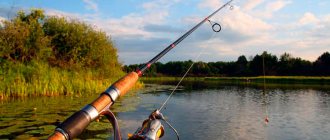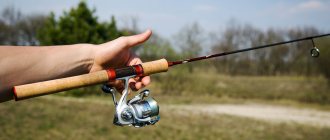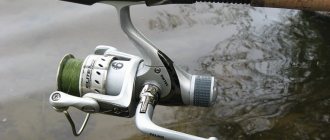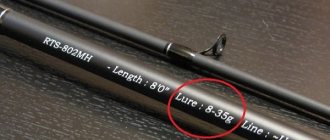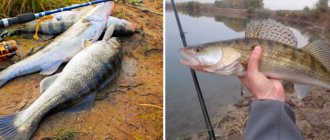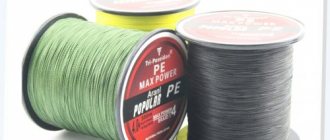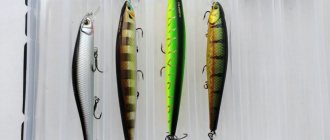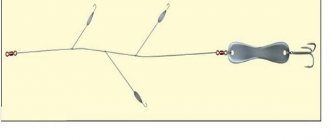Today there are a large number of different models on the market to suit every taste. Each spinning rod is designed to catch a specific fish.
In order to be able to understand the variety of spinning rods, there are classifications according to purpose and parameters:
- For fishing in the southern zone of Russia, it is necessary to use powerful baits and durable fishing rods.
- Delicate equipment is perfect for fishing in the conditions of central Russia.
- In the northern regions, strict requirements are imposed on equipment (reliability, strength, etc.).
Types of spinning rods
All models are divided into two-handed and one-handed. Let's take a closer look at each variety.
- One-handed . This is the most common variety. These rods must be held in one hand. One-handed ones have less accuracy and power than two-handed ones.
- Two-handed. As a rule, these models are used for fishing from the shore. They provide longer and more powerful casting.
1 – two-handed telescopic spinning rod, 2 – one-handed spinning rod
How to make an accurate cast with a spinning rod
The accuracy and range of casting tackle is achieved with well-placed equipment. Maximum accuracy can be achieved only in one way - the overhead swing method. In order for the throw to be accurate, you need to move the shaft behind your head and prepare to swing.
The trajectory of the tackle must be straight. After the swing, you need to make sure that the rod tip remains in the forward position. The flight distance of the bait is controlled using a finger, which slows down or stops the entire process by clamping the line.
Factors affecting casting quality
Quality is influenced by a large number of different factors:
- wind;
- obstacles on the shore;
- compactness of the bait used;
- weight and aerodynamics of the bait;
- fishing line;
- coil used;
- rings;
- rod action, test and length;
- line diameter.
Rod design
For each rod there is a certain technique that will be optimal. It depends on the length and structure of the form: for some, softer and sweeping throws are preferable, for others it will be better to practice short and sharp ones.
If an angler regularly fishes with a particular spinning rod, he will be able to hone his casting skills with this rod in different conditions.
Bad weather
When fishing with a spinning rod, it is necessary to make allowances for the wind: the side wind has a significant impact on the accuracy of the cast, and the headwind or the wind at the back has a significant impact on the casting distance.
Wind is one of the factors, namely:
- Side wind. Leads to a significant reduction in accuracy as well as range.
- The wind is in your face. Such weather conditions lead to reduced range.
- The wind is at your back. Leads to a significant increase in casting distance.
Casting range
Date: March 6, 2015 | 891
When fishing with a spinning rod, very often the question of the range of the tackle arises. How far can a spinning rod cast a bait? In some cases, this is not critical, because fishing takes place next to the fisherman. This is not so important when fishing from a boat, when we can get closer to the desired point. But this is very important if the fish concentrates at a certain distance from the shore, and we need to get it there. To make long casts with a spinning rod, you need to arrange the tackle correctly. And for this, you need to understand on what factors the range of the gear depends. This is what we will deal with now.
Almost any element of a spinning rod affects the range of the tackle. Let's analyze each element in abstract form. What helps increase casting distance and what reduces it.
A spinning rod is one of the most key factors determining casting distance.
The longer the spinning rod, the further you can cast.
Rods with medium and fast action, longer-reaching than super-fast and parabolic. Because they combine both rigidity and a certain element of a whip, a sling, which helps to make a sharp cast.
Rods with a hollow tip, which is an organic continuation of the entire blank, have a longer range than spinning rods with glued tips.
The more guide rings there are on the rod, the worse the casting distance due to the friction of the cord in the rings. And vice versa, the fewer rings, the higher the range (of course, within reasonable limits, usually there are no less than 5 rings).
The larger the rings in diameter, the higher the casting range.
Coil.
The larger the diameter of the reel spool, the longer the fishing tackle.
The more full the spool is, the further you can cast.
The spool collar must be even, perfectly smooth, without damage or adhering dirt. Otherwise, the casting range will be reduced.
Cord.
The thinner the line or cord, the further the cast.
The softer the line, the further the cast (this is also why cords have a longer range than line).
The more slippery the surface of the line, the further the cast.
The closer the cross-section of the cord is to a perfectly round one, the higher the casting distance.
Bait.
The heavier the bait, the further you can throw it.
The weight of the bait must be within the test range of the spinning rod. A lighter bait than the bottom test greatly reduces the casting distance. Heavier - than the upper limit of the test - good range, but not safe for the rod.
A more compact, smaller bait has a longer range.
Silicone on a joint flies further than on a jig head of the same weight.
So, by varying these theses, combining them with the strength requirements for gear, we achieve the most harmonious layout of a spinning rod with a high casting range.
Share with your friends:
Categories: Tackle · Tags: Range, Reel, Line, Tackle, Spinning, Rod, Cord
Typical mistakes of novice fishermen
Often, inexperienced anglers fail when mastering various techniques. Let's look at the most common mistakes:
- Beginners often use a reel without a line guide . Such a coil often fails (gets tangled). How to avoid this? When winding, you need to help a little with your thumb.
- Inexperienced fishermen often use light baits. But you need to take into account that if small guide rings are installed on the spinning rod, then it will be impossible to cast long distances.
Therefore, when choosing a fishing rod, it is necessary to take into account the size of the baits that will be used. - A common mistake beginners make is putting too much line on the reel. If you use a standard spinning reel, the line may get tangled when unwinding. Therefore, you should not wind a large amount of fishing line.
- Beginners often place the rod over their shoulder incorrectly .
This way the bait hangs down to the ground. This technique is unacceptable, as it can lead to serious consequences.
Methods for weighting a spinner
Before you begin to weight the spinner, you should prepare all the tools and materials that may be needed. It is best to purchase small tungsten jigs, which in this case are perfect.
Important! When buying tungsten jigs, you should pay attention to the hole inside them, which should be at least 1 mm.
As for the diameter of the bait itself, it can be from 4 to 7 mm. In addition, you will also need to take a rigid wire with a cross-section of 0.5-0.8 mm. If we talk about tools, then you will need to stock up on wire cutters and pliers.
Having purchased everything you need, you can start.
I would like to say right away that many fishermen weigh down elements that have proven themselves to be the best. Many of their spinners are universal, and the rotation angle is 45 degrees. This means that such an element can be used everywhere. If you make it even heavier, then there will be no value for it.
Tips and tricks
First, the fisherman must choose a suitable place. The correct position allows you to increase your catch several times. When choosing a position you need to consider:
- amplitude of movement of the bait used;
- flow;
- vegetation;
- various obstacles.
Tips for choosing a casting technique:
- With two hands . Allows you to increase power several times. Thus, the casting distance is maximized.
- From under the hand. Used in reservoirs with dense vegetation, as well as when fishing with two people from a boat.
- Lateral . This technique is effective in strong winds and abundant vegetation.
- Over shoulder . Effective in narrow spaces.
- Over the head . The main advantage is accuracy.
Only you decide which casting method to choose, the main thing is that it is effective!
Casting technique
Unfortunately, learning to cast far from a book is quite difficult. In my opinion, the best option is to watch the video or see “live” how the “truck drivers” throw. Undoubtedly, casting technique is absolutely individual, but it must be formed based on clear knowledge. For example, the most common mistake when casting with a spinning reel is releasing the line too early. The rod at this moment is directed at an angle of 85-70 to the horizon, the bait flies high up, describes a steep parabola and splashes down too close, having previously selected a huge loop of fishing line. If the line is released too late, the tip is tilted at about an angle of 25-35, the bait flies almost under your feet and falls into the water with a lot of splashes. In most situations, the optimal angle for releasing the fishing line is 45-50; first, it is enough to achieve at least this, and only then hone the accuracy and maximum range.
The simplest and most realistic way to achieve success on a large river is to increase your casting distance. Practice shows that the gear of many spinning players allows them to reach only the nearest fairway edge.
Mass of bait. In this case, we are limited by three factors: the heavier the bait, the farther you can throw it, but its weight is limited by the rod test and the quality of the jig bait (for oscillating and rotating spoons and jigs, this is not so critical). These limiting factors can be dealt with in different ways. For example, use a rod with a wider test range or a compact jig bait with positive buoyancy. In my opinion, the ideal candidate for this role is a polyethylene foam fish. To ensure high-quality fishing under identical fishing conditions with a size and volume equal to other and similar baits, the “polyethylene foam” requires a load of 3-5 g more.
How to cast a spinning rod with a spinning reel
A spinning rod with a spinning reel is ideal for casting over long distances - up to 20 m. A complete set of tackle should include:
- a fishing line 100 m long, capable of withstanding a minimum load of 7-8 kg;
- sinkers - 4 pcs., for tensioning the fishing line;
- a special carabiner - a swivel, or swivel, that keeps the fishing line from twisting;
- leash and hook.
The length of the overhang of the bait should reach the middle of the length of the rod. The swing is carried out by moving the rod to the side. To ensure that the range does not affect the accuracy, you need to strictly control the position of the fishing line - it must fit into the reel. After completing the swing, the position of the fishing line must be fixed.
Before the feeder sinks too deep, the line is reeled in, positioning the rod in such a way that a right angle is formed between them.
The direction and strength of the wind directly affects the flight range. It will be possible to increase the distance by more than 30 m in a position with your back to the direction of the wind.

